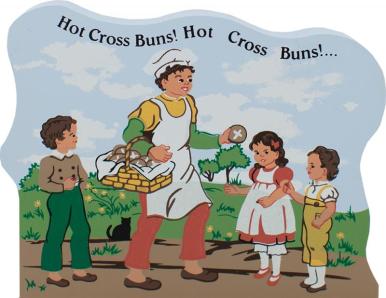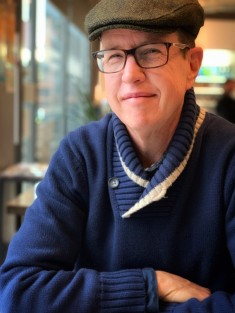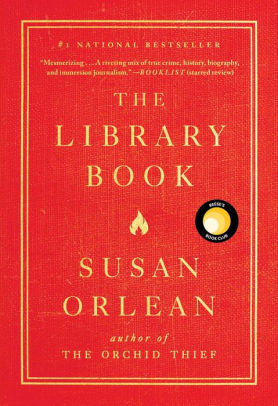
One of my favorite songs from childhood that is also the quintessential early tunes a beginning piano or band student learns to play is Hot Cross Buns. Containing only 3 stepwise notes, it is easy to learn as well as catchy enough to get stuck in one’s head for the rest of the day.
But what exactly are these strange treats that could be bought for a mere penny or two, as the song states: “One a penny, two a penny, hot cross buns”? The silly children’s rhyme appears to hearken back to a street vendor song, much like our TV commercial jingles are used today, and likely English in origin. But is there more to the rhyme than a baker hawking his wares and vying for customers? I determined to find out and when I learned the significance behind the crossed buns, I decided March would be a fitting time to try these early American hearth cooking style at the 1820 Colonel Benjamin Stephenson House kitchen.
Ingredients list
 1 cup milk (scalded) 1/4 cup currents
1 cup milk (scalded) 1/4 cup currents
2 1/2 cups white flour (sifted) 1 egg
1/2 teaspoon salt
1/4 cup sugar Frosting:
1/8 teaspoon cinnamon 1/2 cup confectioner’s sugar
1/8 teaspoon nutmeg 1 – 2 tablespoons milk
There are many variations on recipes for Hot Cross Buns; some use more spices, some have citron along with currents. I did not have citron available on my pantry shelf and actually substituted golden raisins for currents, which are very close cousins of each other. In other similar bread recipes, I’ve successfully interchanged these dried fruits with little difference in taste or texture. I am more familiar with buns using frosting crosses on them, which is what I chose for my baking today. However, more traditional recipes call for alternate colored dough baked across the tops of the buns. It always baffled me how to serve these “hot” without melting off the frosting crosses. The baked in cross makes so much more sense and someday I will try these as well. But this has been a busy month, so I defaulted to what I knew best and went for the more modern frosted versions.
 It was a busy Saturday at the Stephenson House with four other young volunteers in the midst of starting their own baking project when I arrived. A nice fire was already on its way to making a bed of coals and I set the cup of milk boiling, which took much longer than it would have on my modern range top.
It was a busy Saturday at the Stephenson House with four other young volunteers in the midst of starting their own baking project when I arrived. A nice fire was already on its way to making a bed of coals and I set the cup of milk boiling, which took much longer than it would have on my modern range top.
But scalding the milk and then letting it cool just to “blood warm” temperature (101 – 105 ° F) While this step may seem a little strange, the point is not to kill bacteria from a long ago time before pasteurization (as I was once told) and therefore unnecessary to modern bread baking.

Actually, by scalding the milk it creates a chemical reaction that makes the bread lighter and fluffier by eliminating the protein in milk, allowing the gluten to work and also helps in dissolving the sugars and yeast resulting in a more refined texture.
Sifting the Flour
This also may seem like a putzy and tedious thing to do, but actually, it is not to be

skipped. I admit to having done this when in a hurry to throw together a batch of rolls or bread for dinner. But it is well worth taking the time to do so. I had Molly help, after she showed a curiosity for the vintage sifter, a family heirloom from my husband’s grandmother. It is very much like one I remember my own mom using. Sifting flour was one of my favorite things to do as a child.
“But what exactly does sifting do?” Molly wanted to know.
Good question! Flour long ago was not as well milled before our modern high powered machinery. Also, it was sold in large cloth sacks of at least ten or twenty-five pounds. People did a lot more home baking in those days and stocked up! Regular flour might be fine for denser breads or biscuits, but for something like sweet breads or cakes, a finer milling makes all the difference between a heavy lumpy roll and a light airy cake. Even today, it helps to take that extra step to sift all purpose flour and is really the only difference between that and more expensive cake flour.
Once the milk was processed and cooled enough, I added the yeast and sugar mixed with spices and then mixed in the egg. I’m getting pretty handy at nipping sugar from the cone with those antique nippers. After sifting the flour, I added the currents (golden raisins) and mixed them in until they were evenly distributed and lightly coated. Next step was to mix wet and dry ingredients together and knead them into a soft dough. I added the yeast mixture in small doses to the center of the flour, making a “well” and folding in the edged toward the center. This is my favorite part when it all starts coming together and I can actually get my hands in the dough. Yes, that pun was intentional. LOL!

The dough rises twice, once as a solid mass and then then is reworked again to be formed into small round balls, which rise again until doubled and then baked. The fire must have been extra hot today. The buns baked in record time, just under an hour, which is about the length of time it takes in my home oven at about 350 degrees F.
When they were slightly cooled I mixed the powdered sugar with the milk, adding just a few drops at a time until the consistency was soft and drip-able (is that a word?) but not too runny. It needs to set up and actually look like a cross, or it won’t be a hot cross bun. Right? OK. Maybe they weren’t actually “hot” when served, but I’m still calling them hot cross buns. Don’t they look pretty sitting on Ben’s table all set for dinner? I doubt if he would have served them in Edwardsville, but who knows? Maybe the Stephenson kids ran around the house singing the song and asked for these baked treats. Perhaps if they were not aware of the origin, they might have enjoyed this old English sweet bun, brought to the New World. However, staunch Presbyterians, like the Stephenson family, would likely not have abided such “Romanish” practices. More’s the pity for them, missing this charming and delicious spring treat. 
Historical Context
No one really know how far back these sweet bread treats go, but its origins appear rooted in England sometime in the Middle Ages and may be descended from an even earlier tradition dating back to Roman paganism. In honor of Eostre, the goddess of spring and the dawn, spiced bread dough, studded with fruit, was baked for her feast day.
Later, with the spread of Christianity, the crosses were added as a reminder of penance and faith. It was also an assurance the buns had been “blessed” and therefore could ward off evil spirits or at least was guaranteed not to mold. By the late 1600s, these early fruited breads became known as “Good Friday Buns” to be served for breakfast on the fifth day of Holy Week, the day Christians commemorate Christ’s crucifixion. Today, hot cross buns are often stocked on grocery store and bakery shelves all during the Lenten season. Some Christians eat them on Ash Wednesday as a tradition to kick off the Lenten season and others partake of them anytime during the forty day season. According to one of my fellow kitchen volunteers, his grandmother serves these as dinner rolls at their Easter feast, a hearkening back to the ancient origins.
Whatever the reason or the season, these buns are one tasty delicacy that are not all that hard to master, for any dedicated bread baker. Whether baked in a modern gas or electric oven or over an early 19th century hearth, the experience of baking, serving and eating a treat that has a history well over a thousand years old and immortalized in a children’s song, make these not only a treat for the stomach, but food for the soul, a just plain old time fun!

 By 2:27 on a Thursday afternoon, the one-legged man from Room 8 at 147 Loxitor Avenue has been beaten to death with a lead pipe. Twenty-eight minutes later, Detective Mike O’Shea is testifying in a stuffy courtroom, unaware that, within an hour, he will be standing in an alleyway littered with beer cans and condoms while his new partner—the man who saved his life thirteen years ago—flicks bugs off of a battered corpse with a ballpoint pen. When a rogue undercover copper prematurely hauls in the prime suspect, Mike blows a fuse, resulting in an unlikely rapport developing between him and the lead homicide detective sergeant, a woman known for her stilettos and razor sharp investigative skills. At the end of his seventy-two-hour shift, three men are dead and Mike O’Shea is floating in and out of consciousness in an emergency room hallway, two women by his side. Death Before Coffee, the second book in the Mike O’Shea Crime Fiction Series, weaves a homicide investigation through the life of an inner-city police detective intent on balancing his responsibilities as a son, brother, and newly single father with his sworn oath of duty. When faced with death, Mike is forced to make decisions that stir up old memories, compelling him to confront his demons while fighting the good fight.
By 2:27 on a Thursday afternoon, the one-legged man from Room 8 at 147 Loxitor Avenue has been beaten to death with a lead pipe. Twenty-eight minutes later, Detective Mike O’Shea is testifying in a stuffy courtroom, unaware that, within an hour, he will be standing in an alleyway littered with beer cans and condoms while his new partner—the man who saved his life thirteen years ago—flicks bugs off of a battered corpse with a ballpoint pen. When a rogue undercover copper prematurely hauls in the prime suspect, Mike blows a fuse, resulting in an unlikely rapport developing between him and the lead homicide detective sergeant, a woman known for her stilettos and razor sharp investigative skills. At the end of his seventy-two-hour shift, three men are dead and Mike O’Shea is floating in and out of consciousness in an emergency room hallway, two women by his side. Death Before Coffee, the second book in the Mike O’Shea Crime Fiction Series, weaves a homicide investigation through the life of an inner-city police detective intent on balancing his responsibilities as a son, brother, and newly single father with his sworn oath of duty. When faced with death, Mike is forced to make decisions that stir up old memories, compelling him to confront his demons while fighting the good fight. For almost thirty years, Desmond P. Ryan began every day of his working life with either a victim waiting in a hospital emergency room, or a call to a street corner or a blood-soaked room where someone had been left for dead. Murder, assaults on a level that defied humanity, sexual violations intended to demean, shame, and haunt the individuals who were no more than objects to the offenders: all in a day’s work. It was exhilarating, exhausting, and often heartbreaking.
For almost thirty years, Desmond P. Ryan began every day of his working life with either a victim waiting in a hospital emergency room, or a call to a street corner or a blood-soaked room where someone had been left for dead. Murder, assaults on a level that defied humanity, sexual violations intended to demean, shame, and haunt the individuals who were no more than objects to the offenders: all in a day’s work. It was exhilarating, exhausting, and often heartbreaking.